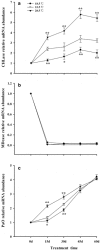Effects of different growth temperatures on growth, development, and plastid pigments metabolism of tobacco (Nicotiana tabacum L.) plants
- PMID: 29404808
- PMCID: PMC5799153
- DOI: 10.1186/s40529-018-0221-2
Effects of different growth temperatures on growth, development, and plastid pigments metabolism of tobacco (Nicotiana tabacum L.) plants
Abstract
Background: Temperature remarkably affects the growth and metabolism of plants. Tobacco is an important cash crop, and the long-term effects of different growth temperatures (18.5, 23.5 and 28.5 °C, daily average) on growth, development and plastid pigments metabolism of tobacco plants were investigated in this study.
Results: Compared with tobacco plants grown under 23.5 °C, treatments with 18.5 and 28.5 °C inhibited the expansion of leaves. The contents of superoxide anion (O 2·- ), hydrogen peroxide (H2O2) and malonaldehyde (MDA) in the leaves were significantly increased under 28.5 °C from 0 to 60 days, which in turn accelerated the flowering and senescence of tobacco plants. By contrast, the treatment with 18.5 °C remarkably decreased O 2.- , H2O2 and MDA, and delayed the flowering and senescence. Furthermore, treatment with 18.5 °C significantly up-regulated the expression of glutamyl-tRNA reductase (Glu-TR) and magnesium chelatase (MgCH), and down-regulated the ferri chelatase (FeCH), protochlorophyllide oxidoreductase, chlorophyllase (CHLase), phaeophorbide a monooxygenase (PaO) and phytoene synthase (PSY), which further promoted the accumulation of chlorophyll (Chls) and reduced the carotenoids (Cars) in leaves. On the contrary, exposing to 28.5 °C remarkably down-regulated the Glu-TR and MgCH, and up-regulated the FeCH, CHLase, PaO and PSY, which in turn decreased the Chls and increased the Cars in tobacco leaves.
Conclusion: As compared with the plants grown under 23.5 °C, lower (18.5 °C) and higher (28.5 °C) growth temperature inhibited the growth of tobacco plants. In general, treatment with 28.5 °C accelerated the flowering and senescence of tobacco plants by enhancing the accumulation of O 2.- and H2O2 in leaves, while exposing to 18.5 °C had the opposite effects. Treatment with 18.5 °C increased the content of Chls and reduced the Cars in leaves. In contrast, Treatment with 28.5 °C decreased the Chls and increased the Cars. Moreover, both O 2.- and H2O2 took part in the breakdown of Chls in tobacco leaves to some extent. The results suggest that growth temperature could regulate growth, development, and plastid pigments metabolism, and 23.5 °C could be an optimal temperature for growth, development and metabolism of plastid pigments of tobacco plants under the experimental conditions.
Keywords: Growth and development; Growth temperature; Plastid pigments metabolism; Regulation; Tobacco plants.
Figures








Similar articles
-
Comparative Proteomic Analysis by iTRAQ Reveals that Plastid Pigment Metabolism Contributes to Leaf Color Changes in Tobacco (Nicotiana tabacum) during Curing.Int J Mol Sci. 2020 Mar 31;21(7):2394. doi: 10.3390/ijms21072394. Int J Mol Sci. 2020. PMID: 32244294 Free PMC article.
-
[Hydrogen peroxide is involved in regulation of tobacco leaf senescence].Fen Zi Xi Bao Sheng Wu Xue Bao. 2009 Feb;42(1):82-8. Fen Zi Xi Bao Sheng Wu Xue Bao. 2009. PMID: 19306693 Chinese.
-
The antioxidative defense system is involved in the premature senescence in transgenic tobacco (Nicotiana tabacum NC89).Biol Res. 2016 Jul 2;49(1):30. doi: 10.1186/s40659-016-0088-1. Biol Res. 2016. PMID: 27370650 Free PMC article.
-
RNAi based simultaneous silencing of all forms of light-dependent NADPH:protochlorophyllide oxidoreductase genes result in the accumulation of protochlorophyllide in tobacco (Nicotiana tabacum).Plant Physiol Biochem. 2013 Oct;71:31-6. doi: 10.1016/j.plaphy.2013.06.025. Epub 2013 Jul 3. Plant Physiol Biochem. 2013. PMID: 23867601
-
Growth of tobacco in short-day conditions leads to high starch, low sugars, altered diurnal changes in the Nia transcript and low nitrate reductase activity, and inhibition of amino acid synthesis.Planta. 1998 Dec;207(1):27-41. doi: 10.1007/s004250050452. Planta. 1998. PMID: 9951717
Cited by
-
Tobacco production under global climate change: combined effects of heat and drought stress and coping strategies.Front Plant Sci. 2024 Nov 26;15:1489993. doi: 10.3389/fpls.2024.1489993. eCollection 2024. Front Plant Sci. 2024. PMID: 39670262 Free PMC article. Review.
-
The Potential Roles of Unique Leaf Structure for the Adaptation of Rheum tanguticum Maxim. ex Balf. in Qinghai-Tibetan Plateau.Plants (Basel). 2022 Feb 14;11(4):512. doi: 10.3390/plants11040512. Plants (Basel). 2022. PMID: 35214845 Free PMC article.
-
Adjustments of the Phytochemical Profile of Broccoli to Low and High Growing Temperatures: Implications for the Bioactivity of Its Extracts.Int J Mol Sci. 2024 Mar 26;25(7):3677. doi: 10.3390/ijms25073677. Int J Mol Sci. 2024. PMID: 38612494 Free PMC article.
-
Study on the change of global ecological distribution of Nicotiana tabacum L. based on MaxEnt model.Front Plant Sci. 2024 Jul 17;15:1371998. doi: 10.3389/fpls.2024.1371998. eCollection 2024. Front Plant Sci. 2024. PMID: 39091317 Free PMC article.
-
Comparative transcriptome analysis reveals the key role of photosynthetic traits in the formation of differences in photothermal sensitivity in tobacco.BMC Genomics. 2025 Jan 28;26(1):84. doi: 10.1186/s12864-025-11253-1. BMC Genomics. 2025. PMID: 39875828 Free PMC article.
References
-
- Adachi M, Shimokawa K. Evidence for the involvement of superoxide anion in the ethylene-inducted chlorophyll a catabolism of Raphanus sativus cotyledons. Phytochemistry. 1995;3:527–530. doi: 10.1016/0031-9422(95)00012-V. - DOI
-
- Apel K, Santel HJ, Redlinger TE, Falk H. The protochlorophyllide holochrome of barley (Hordeum Vulgare L.). Isolation and characterization of the NADPH: protochlorophyllide oxidoreductase. FEBS J. 1980;111:251–258. - PubMed
Grants and funding
- No. 31260064/National Natural Science Foundation of China
- No. 31460059/National Natural Science Foundation of China
- 110201101003 TS03/special project of science and technology State Tobacco Monopoly Bureau, China
- 2014YN16/China National Tobacco Corporation
- 01700205020516002/The New Ph.D. Candidate Academician Scholarship of Yunnan Province of 2016
LinkOut - more resources
Full Text Sources
Other Literature Sources
Research Materials

